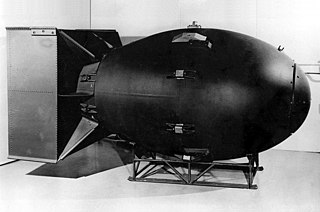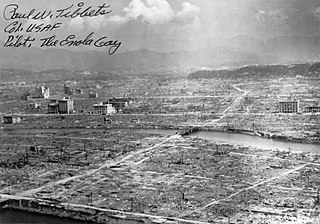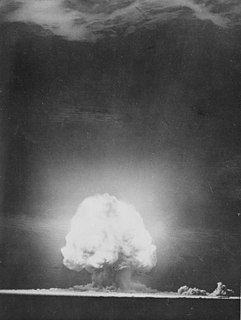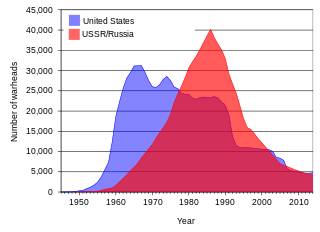
The Cuban Missile Crisis, also known as the October Crisis of 1962, the Caribbean Crisis, or the Missile Scare, was a 13-day confrontation between the United States and the Soviet Union initiated by the American discovery of Soviet ballistic missile deployment in Cuba. The confrontation is often considered the closest the Cold War came to escalating into a full-scale nuclear war.

Nuclear warfare is a military conflict or political strategy in which nuclear weaponry is used to inflict damage on the enemy. Nuclear weapons are weapons of mass destruction; in contrast to conventional warfare, nuclear warfare can produce destruction in a much shorter time and can have a long-lasting radiological warfare result. A major nuclear exchange would have long-term effects, primarily from the fallout released, and could also lead to a "nuclear winter" that could last for decades, centuries, or even millennia after the initial attack. Some analysts dismiss the nuclear winter hypothesis, and calculate that even with nuclear weapon stockpiles at Cold War highs, although there would be billions of casualties, billions more rural people would nevertheless survive. However, others have argued that secondary effects of a nuclear holocaust, such as nuclear famine and societal collapse, would cause almost every human on Earth to starve to death.

In nuclear strategy, a first strike is a preemptive surprise attack employing overwhelming force. First strike capability is a country's ability to defeat another nuclear power by destroying its arsenal to the point where the attacking country can survive the weakened retaliation while the opposing side is left unable to continue war. The preferred methodology is to attack the opponent's strategic nuclear weapon facilities, command and control sites, and storage depots first. The strategy is called counterforce.

Mutual assured destruction or mutually assured destruction (MAD) is a doctrine of military strategy and national security policy in which a full-scale use of nuclear weapons by two or more opposing sides would cause the complete annihilation of both the attacker and the defender. It is based on the theory of deterrence, which holds that the threat of using strong weapons against the enemy prevents the enemy's use of those same weapons. The strategy is a form of Nash equilibrium in which, once armed, neither side has any incentive to initiate a conflict or to disarm.

World War III and the Third World War are names given to a hypothetical third worldwide large-scale military conflict subsequent to World War I and World War II. The term has been in use since at least as early as 1941. Some have applied it loosely to refer to limited or smaller conflicts such as the Cold War or the War on Terror, while others assumed that such a conflict would surpass prior world wars both in its scope and its destructive impact.
An invasion is a military offensive in which large parts of combatants of one geopolitical entity aggressively enter territory controlled by another such entity, generally with the objective of either conquering; liberating or re-establishing control or authority over a territory; forcing the partition of a country; altering the established government or gaining concessions from said government; or a combination thereof. An invasion can be the cause of a war, be a part of a larger strategy to end a war, or it can constitute an entire war in itself. Due to the large scale of the operations associated with invasions, they are usually strategic in planning and execution.

Nuclear weapons possess enormous destructive power from nuclear fission or combined fission and fusion reactions. Building on scientific breakthroughs made during the 1930s, the United States, the United Kingdom and Canada collaborated during World War II, in what was called the Manhattan Project, to counter the suspected Nazi German atomic bomb project. In August 1945, two fission bombs were dropped on Japan, standing to date as the only use of nuclear weapons in combat. The Soviet Union started development shortly thereafter with their own atomic bomb project, and not long after that both countries developed even more powerful fusion weapons known as "hydrogen bombs".
A code name or cryptonym is a word or name used, sometimes clandestinely, to refer to another name, word, project or person. Names are often used for military purposes, or in espionage. They may also be used in industrial counter-industrial espionage to protect secret projects and the like from business rivals, or to give names to projects whose marketing name has not yet been determined. Another reason for the use of names and phrases in the military is that they transmit with a lower level of cumulative errors over a walkie-talkie or radio link than actual names.

Technology played a significant role in World War II. Some of the technologies used during the war were developed during the interwar years of the 1920s and 1930s, much was developed in response to needs and lessons learned during the war, while others were beginning to be developed as the war ended. Many wars had major effects on the technologies that we use in our daily lives. However, compared to previous wars, World War II had the greatest effect on the technology and devices that are used today. Technology also played a greater role in the conduct of World War II than in any other war in history, and had a critical role in its final outcome.

The GIUK gap is an area in the northern Atlantic Ocean that forms a naval choke point. Its name is an acronym for Greenland, Iceland, and the United Kingdom, the gap being the open ocean between these three landmasses. The term is typically used in relation to military topics.

Air supremacy and air superiority is the concept of your side in war having a better/larger air force than your enemies. Control of the air is the aerial equivalent of command of the sea.

The nuclear arms race was an arms race competition for supremacy in nuclear warfare between the United States, the Soviet Union, and their respective allies during the Cold War. During this period, in addition to the American and Soviet nuclear stockpiles, other countries developed nuclear weapons, though none engaged in warhead production on nearly the same scale as the two superpowers.

The Single Integrated Operational Plan (SIOP) was the United States' general plan for nuclear war from 1961 to 2003. The SIOP gave the President of the United States a range of targeting options, and described launch procedures and target sets against which nuclear weapons would be launched. The plan integrated the capabilities of the nuclear triad of strategic bombers, land-based intercontinental ballistic missiles (ICBM), and sea-based submarine-launched ballistic missiles (SLBM). The SIOP was a highly classified document, and was one of the most secret and sensitive issues in U.S. national security policy.
A decapitation strike is a military strategy aimed at removing the leadership or command and control of a hostile government or group. The strategy of shattering or defeating an enemy by eliminating its military and political leadership has long been utilized in warfare.
Massive retaliation, also known as a massive response or massive deterrence, is a military doctrine and nuclear strategy in which a state commits itself to retaliate in much greater force in the event of an attack.

Flexible response was a defense strategy implemented by John F. Kennedy in 1961 to address the Kennedy administration's skepticism of Dwight Eisenhower's New Look and its policy of massive retaliation. Flexible response calls for mutual deterrence at strategic, tactical, and conventional levels, giving the United States the capability to respond to aggression across the spectrum of war, not limited only to nuclear arms.

This is a timeline of the main events of the Cold War, a state of political and military tension after World War II between powers in the Western Bloc and powers in the Eastern Bloc.

A nuclear triad is a three-pronged military force structure that consists of land-launched nuclear missiles, nuclear-missile-armed submarines and strategic aircraft with nuclear bombs and missiles. Specifically, these components are land-based intercontinental ballistic missiles (ICBMs), submarine-launched ballistic missiles (SLBMs), and strategic bombers. The purpose of having this three-branched nuclear capability is to significantly reduce the possibility that an enemy could destroy all of a nation's nuclear forces in a first-strike attack. This, in turn, ensures a credible threat of a second strike, and thus increases a nation's nuclear deterrence. The main theory of creating the nuclear triad was to spread the assortment of weapons across various platforms, making military forces more likely to survive an attack and able to respond to a first strike successfully. The military strategy of distributing weapons over the three platforms developed as an answer to countries' concerns when surviving a nuclear strike. This would ensure that nuclear forces could survive a first strike and be deployed in a retaliatory strike, resulting in "mutual assured destruction."

First Strike is a 1979 film created by KRON-TV and Chronicle Publishing Company under the broadcast division name "Chronicle Broadcasting Company" in partnership with the United States Department of Defense and the RAND Corporation that discusses the United States armed forces strategy for dealing with nuclear warfare. The film became far better known when various clips were edited into the 1983 TV film The Day After.

An air force, also known in some countries as an aerospace force or air army, is in the broadest sense, the national military branch that primarily conducts aerial warfare. More specifically, it is the branch of a nation's armed services that is responsible for aerial warfare as distinct from an army or navy. Typically, air forces are responsible for gaining control of the air, carrying out strategic and tactical bombing missions, and providing support to land and naval forces often in the form of aerial reconnaissance and close air support.































